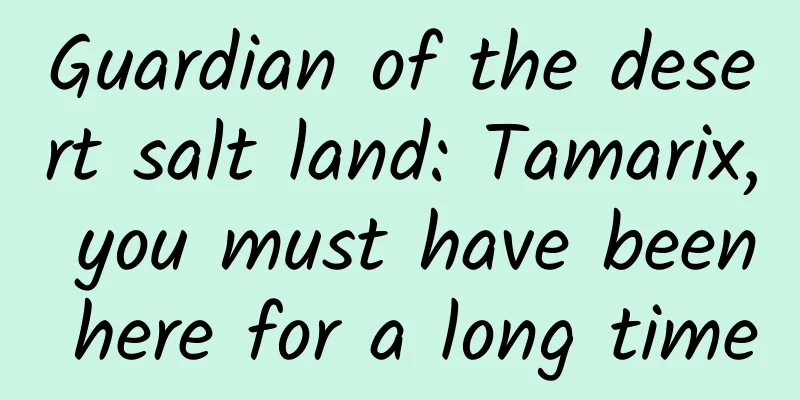Guardian of the desert salt land: Tamarix, you must have been here for a long time

|
In the vast Gobi Desert of the northwest, there is a most common and common plant. It has no majestic body, no graceful figure, and no sweet fruit, but it has the most persistent root system, which is closely attached to the Gobi Desert, turning the Gobi Desert into a fertile land and adding green hope. It is the tamarisk, a symbol of the plateau spirit. Tamarix is a shrub or tree belonging to the family Tamarix. It is also known as red willow. There are two types of branches: woody growth branches that do not fall off in winter, and green nutrient branches that fall off in winter. Tamarix is 1 to 5 meters tall, with thin and soft branches and dense crowns. It blooms pink spikes in summer. When it blooms, the light red inflorescence blooms on the top of the tender green branches and leaves, swaying in the wind, undulating, fresh and eye-catching. It is understood that there are about 90 species of Tamarix in the world, and my country has 18 species and 1 variant. my country is mainly distributed in Northwest China, Inner Mongolia and North China. File photo: Tamarix in full bloom in Babusha Forest Farm Tamarix has a strong tolerance to salt and alkali, and can grow normally a few meters away from seawater and on heavily saline-alkali land with a salt content of more than 1%. Tamarix plants are also typical salt-secreting plants, which can excrete the salt absorbed into the body through salt-secreting pores. The salt in the dead branches and leaves often sticks together with sand particles to form "red willow sand bags", which have strong wind-proof and sand-fixing properties and can tolerate sand burial, and can effectively improve soil quality. After afforestation of Tamarix as a "pioneer tree species" for three years, other tree species can be planted in the original place. A large area of Tamarix grows on the saline-alkali land of the Yellow River Delta, accounting for about 21% of the natural vegetation in the area. Tamarix can not only survive in heavily saline-alkali land and coastal mudflats, and has no frost damage in areas below -35 degrees Celsius, but can also thrive in extremely barren and arid areas of the desert and semi-desert in northwest my country, and has inestimable ecological value for the restoration of the ecological environment in the country's desert areas. The roots of tamarisks under sand dunes are deeper, and their tentacles are very long, with the deepest and longest reaching more than 30 meters. They have obvious wind-proof effects and strong sand-blocking capabilities. Therefore, tamarisks are important afforestation species for windbreak, sand fixation, and improvement of saline-alkali land in desert areas. In addition to being the guardian of desert salt land, Tamarix is also an important feed for camel farming in my country's arid regions. In spring and summer, camels' favorite food is the tender branches of Tamarix. In addition, red willow can be used as medicine. The high and cold natural climate makes it easy for plateau people to suffer from rheumatism. The tender branches and green leaves of Tamarix are good medicines for treating this stubborn disease, helping many people get rid of the pain. Therefore, local people affectionately call red willow "Guanyin willow" and "Bodhisattva tree". Tamarix is also highly resistant to sulfur dioxide, lead compound pollution, and chlorine pollution in the atmosphere. In addition, Tamarix is one of the hosts of Cistanche tubulosa, which has high medicinal and health value. Planting Tamarix and Cistanche in desert areas not only plays an important role in improving the natural environment and preventing wind and sand, but also becomes a way for farmers to get rich and promotes local economic development. I believe that with our continuous research and exploration, Tamarix will bring more and more ecological and economic benefits. Review expert: Yang Rurong, associate researcher at the Institute of Geography and Natural Resources Research, Chinese Academy of Sciences China Association for Science and Technology Department of Science Popularization Xinhuanet Co-production |
<<: A gamma-ray burst that occurs once in a thousand years! But does it bring more cosmic mysteries?
Recommend
This is how to effectively review your Xiaohongshu campaign!
In the years that I have been doing Xiaohongshu a...
How was the deepest well on land in Asia created?
Workers at Tarim Oilfield are working on the proj...
[Popular Science of Chinese Military Technology] Victory or defeat is decided in silence - how important will electronic confrontation in aerospace be in the future?
With the rapid development of aerospace technolog...
5 marketing strategy ideas to build a brand with lasting competitiveness
Whether it is as small as a promotional activity ...
Operation system [Introduction]: How to do promotion and marketing?
Today I will talk about three points: 1. Third-pa...
WeChat Android version 8.0.16 beta version released
On October 21, WeChat Android platform ushered in...
Volvo launches new mobility brand M to transform into a mobile travel service provider
On July 4, local time, Volvo Cars launched a new ...
How to debug CSS compatibility issues in iPhone Safari browser
If our computer browser has CSS compatibility iss...
Lei Jun, Zhou Hongyi and other business leaders' success secrets courses
From ideals to successful entrepreneurship, Lei J...
Why is the public relations of that video website so "capricious"?
Yes, when you see this title, you must think of t...
Is your belly getting bigger under stress? 6 magic tricks to get rid of "stress fat" →
Do you feel familiar with these scenes: showing o...
The logic of the young LeTV TV super TV: products and users are together
LeTV TV's "919 Music Festival" prom...
Stock Broker Training Camp: Only Know How to Trade Stocks Episode 18
Stock Brother Training Camp: Only Know How to Tra...
What do new media users really like? Here’s a new trend report!
"What do users like to watch?" has beco...
Toutiao account operation and promotion, do you know all these?
In recent years, Toutiao has developed rapidly, a...









